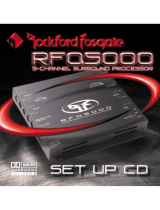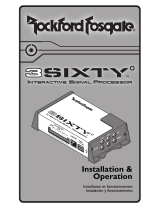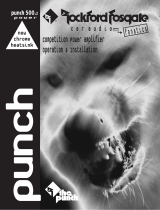La page est en cours de chargement...

® ®
car audio
fanatics
for
1/2 DIn preamplifier
pa2


Dear Customer,
Congratulations on your purchase of the world's finest brand of car audio signal
processors. At Rockford Fosgate we are committed to musical reproduction at its best,
and we are pleased you chose our product. Through years of engineering expertise, hand
craftsmanship and critical testing procedures, we have created a wide range of products
that reproduce music with all the clarity and richness you deserve.
For maximum performance we recommend you have your new Rockford Fosgate
product installed by an Authorized Rockford Fosgate Dealer, as we provide specialized
training through Rockford Technical Training Institute (RTTI). Please read your
warranty and retain your receipt and original carton for possible future use.
To add the finishing touch to your new Rockford Fosgate image order your Rockford
accessories, which include everything from T-shirts and jackets to hats and sunglasses.
To get a free brochure on Rockford Fosgate products and Rockford accessories, in the
U.S. call 602-967-3565 or FAX 602-967-8132. For all other countries, call +001-602-
967-3565 or FAX +001-602-967-8132.
The serial number can be found on the outside of the box. Please record it in
the space provided below as your permanent record. This will serve as
verification of your factory warranty and may become useful in recovering your
equipment if it is ever stolen.
Serial Number: ____________________
Model Number:____________________
If, after reading your manual, you still have questions regarding this product,
we recommend that you see your Rockford Fosgate dealer. If you need further
assistance, you can call us direct at 1-800-669-9899. Be sure to have your serial
number, model number and date of purchase available when you call.
PRACTICE SAFE SOUND™
CONTINUOUS EXPOSURE TO SOUND PRESSURE LEVELS OVER 100dB MAY
CAUSE PERMANENT HEARING LOSS. HIGH POWERED AUTO SOUND
SYSTEMS MAY PRODUCE SOUND PRESSURE LEVELS WELL OVER 130dB.
USE COMMON SENSE AND PRACTICE SAFE SOUND.

T
ABLE
OF
C
ONTENTS
Introduction...............................................................................................1
Accessory Pack .........................................................................................1
Design Features .........................................................................................2
Installation Considerations ..........................................................................5
Mounting Location .....................................................................................6
Wiring the System......................................................................................7
PA2 Installation .........................................................................................8
PA2 Operation.........................................................................................11
Troubleshooting.......................................................................................14
Specifications ..........................................................................................16
Warranty Information ...............................................................................17
International Information...........................................................................18
Sections marked
TROUBLESHOOTING
include recommendations for
curing installation problems
Sections marked
INSTALLATION
include “slam dunk”
wiring connections
I
N
S
T
A
L
L
A
T
I
O
N
® ®
TROUBLE-
S
H
O
O
T
I
N
G
Sections marked
ADVANCED OPERATION
include in-depth
technical information
a
d
v
a
n
c
e
d
O
p
e
r
a
t
i
o
n
Welcome to Rockford Fosgate! This manual is designed to provide information
for the owner, salesperson and installer. For those of you who want quick
information on how to install this product, please turn to the
Installation
Section
of this manual or refer to the icons listed below. Other information can
be located by using the Table of Contents. We, at Rockford Fosgate, have
worked very hard to make sure all the information in this manual is current. But,
as we are constantly finding new ways to improve our product, this information
is subject to change without notice.
GETTING STARTED

– 1 –
I
NTRODUCTION
The PA2 is a stereo 4-band equalizer and preamplifier used to compensate
for differences in music format and to correct for response problems
associated with mobile audio installations.
Two different sources can be fed into the PA2 and independently selected
using the front panel A/B input switch. All input and output connections are
made via gold-plated RCA jacks. Inputs are monitored utilizing signal present
and signal clipping LEDs and can be level matched using the input gain
controls. Three pairs of outputs (Front, Rear and Subwoofer) can be adjusted
using the front/rear fader and subwoofer volume controls. A master volume
control adjusts the overall output level.
Each EQ band can accommodate up to 10dB boost or cut to compensate
for insufficient bass response, excessive mid-bass, and high frequency roll
off. The low frequency EQ center is variable from 40Hz to 80Hz, the midrange
controls are centered at 250Hz and 1kHz, and a special high frequency
hinge filter spans from 1kHz-20kHz.
The PA2 packs powerful features into its small but stylish 1/2 DIN size, and
its red/green backlighting allows for easy integration into any automobile,
making it a great addition for center consoles or in-dash use.
A
CCESSORY
P
ACK
Installation and Operation Manual
(2) Adjustable Mounting Brackets
(4) Phillips Bracket Screws (m5 x 0.88mm x 4mm)
(1) Removable Power Connector

D
ESIGN
F
EATURES
– 2 –
RL
Subwoofer
Output
RLRLRL
RL
Rear
Output
REM
B+ GND
Front
Output
B
Input
A
Input
A
Input
Gain
Clipping LED
Trim Pot
Illumination
Red
Green
21
20
22
19
12
17
16
15
14
13
18
2 3 4
5
1
6
7
8
9
10
11
1k-20kHz
0dB +10dB-10dB +10dB
1kHz
-10dB +10dB
250Hz
-10dB +10dB
Frequency
40Hz 80Hz
Subwoofer
Sub Volume
R Fader F
Volume
Input
A/B
®®

– 3 –
1. A/B Input Switch – Selects between two different sources fed into the
preamp. Sources can be designated as CD/TAPE, CD/VCR AUDIO, CD/
VIDEO GAME AUDIO, etc.
2. Signal Strength/Clipping LED – Illuminates red when a predetermined
threshold is reached. Refer to “clipping LED trim potentiometer” for setup
options.
3. Signal Present LED – Illuminates green when signal is detected on any
of the inputs.
4. Master Volume Control – Controls the overall output amplitude of the
front/rear/subwoofer outputs. The control can be set to its full counter-
clockwise position for zero output or its full clockwise position for
maximum output.
5. Front/Rear Fader – Attenuates the front or rear outputs for the desired
“front stage/rear fill” effect. When set to the rear position, the rear output
level is maintained and the front output level is attenuated. When set to
the front position, the front output level is maintained and the rear output
level is attenuated.
6. Subwoofer Volume Control – Controls the signal amplitude of the
subwoofer outputs.
7. Subwoofer Frequency – Selects the center frequency for the subwoofer
boost/cut control.
8. Subwoofer Boost/Cut – Increases or decreases the amplitude of the
subwoofer center frequency. The control is set to flat (0dB) when
adjusted to its center detent position.
9. 250Hz Boost/Cut – Increases or decreases the amplitude of the 250Hz
center frequency. The control is set to flat (0dB) when adjusted to its
center detent position.
10. 1kHz Boost/Cut – Increases or decreases the amplitude of the 1kHz
center frequency. The control is set to flat (0dB) when adjusted to its
center detent position.
11. 1kHz-20kHz Hinge Filter – Increases the amplitude of the high
frequency hinge filter. The control is set to flat (0dB) when adjusted to
its full counterclockwise position. Maximum boost at 20kHz occurs
when adjusted to its full clockwise position.

12. RCA Input/Output Jacks – The industry standard RCA jacks provide
easy connection for low level preamp signals. They are gold-plated to
resist the signal degradation caused by corrosion.
13. Input “A” – These L & R inputs feed the preamplifier when the front panel
A/B input switch is set to input “A.”
14. Input “B” – These L & R inputs feed the preamplifier when the front panel
A/B input switch is set to input “B.”
15. Front Output – These full range (20Hz to 20kHz) fadable stereo outputs
connect to the amplifier driving the “front stage” speaker system.
16. Rear Output – These full range (20Hz to 20kHz) fadable stereo outputs
connect to the amplifier driving the “rear stage” speaker system.
17. Subwoofer Output – These full range (20Hz to 20kHz) fadable stereo
outputs connect to the amplifier driving the “subwoofer” speaker system.
Technical Note: Creative installations can use the subwoofer outputs as
a full range center channel with dedicated volume control. Just
remember to keep the subwoofer boost/cut control to its flat (center)
position and always think “center channel.”
18. Power Connector – The power connector provides a convenient
connection for ground, power and remote. The connector uses “screw
lock” terminals to secure the power wires and is removable for quick
disconnects.
19. Input “A” Gain Control – The input gain control is factory preset to
match the output of most source units. It can be adjusted to match the
source unit to tape/VCR audio/video game audio inputs.
20. Clipping LED Trim Pot – This potentiometer controls the threshold of the
signal strength/clipping LED. It can be set to illuminate the LED when
clipping occurs (0dB gain overlap) or when the desired amount of gain
overlap (+5dB, +10dB, +15dB) is reached.
21. Red/Green Illumination Switch – Selects the backlighting color to red
or green.
22. B+ Fuse – The internal B+ fuse protects the power supply and battery
from short circuits and power failures.
– 4 –

– 5 –
I
NSTALLATION
C
ONSIDERATIONS
This section focuses on some of the vehicle considerations for installing your new
PA2. Pre-planning your system layout and best wiring routes will save
installation time. When deciding how to lay out your new system, be sure that
each component will be easily accessible for making adjustments.
Before beginning any installation, be sure to follow these simple rules:
1. Be sure to carefully read and understand the instructions before attempting
to install the PA2.
2. For safety, disconnect the negative lead from the battery prior to beginning
the installation.
3. For easier assembly, we suggest you run all wires prior to mounting your PA2
in place.
4. Route all of the RCA cables close together and away from any high current
wires.
5. Use high quality connectors for a reliable installation and to minimize signal
or power loss.
6. Think before you drill! Be careful not to cut or drill into gas tanks, fuel lines,
brake or hydraulic lines, vacuum lines or electrical wiring when working on
any vehicle.
7. Never run wires underneath the vehicle. Running the wires inside the vehicle
provides the best protection.
8. Avoid running wires over or through sharp edges. Use rubber or plastic
grommets to protect any wires routed through metal, especially the firewall.
9. ALWAYS protect the battery and electrical system from damage with proper
fusing. Install the appropriate fuseholder and fuse on the +12V power wire
within 18” (45.7 cm) of the battery terminal.
10. When grounding to the chassis of the vehicle, scrape all paint from the metal
to ensure a good, clean ground connection. Grounding connections should
be as short as possible and always be connected to metal that is welded to
the main body, or chassis, of the vehicle.
The following is a list of tools you will need for installing the PA2.
Red power wire Wire strippers
Blue remote turn-on wire Wire cutters
Black grounding wire Voltmeter
Electric hand drill w/assorted bits Jeweler's slotted screwdriver
Battery post wrench #2 screwdriver

M
OUNTING
L
OCATION
The mounting location for the PA2 should allow easy access to the controls for
making necessary adjustments. The PA2 will most likely be adjusted only at the
time of installation and will not need further adjustment unless changes to the
audio system are performed. To ensure optimum performance, care should be
taken when mounting the preamplifier in the following locations:
Engine Compartment
Mounting the PA2 in the engine compartment will void your warranty. The only
thing that should be mounted in the engine compartment is that big metal thing
that makes the vehicle go fast.
Instrument Panel
Mounting the PA2 in the instrument panel provides optimum access. The unit
should be securely mounted to ensure optimum safety.
Center Console
Mounting the unit in the center console provides optimum access. Be sure the
installation does not interfere with the operation of the gear shift or parking brake.
Glove Box
Mounting the unit in the glove box is adequate, but does not provide easy
access. Glove box mounting should only be done if “Instrument Panel” or “Center
Console” mounting is not acceptable (i.e., maintaining integrity of older vehicles
with metal dashboards).
Under Dash
Mounting the unit under the dash is adequate, but does not provide easy access.
Under dash mounting should only be done if “Instrument Panel” or “Center
Console” mounting is not acceptable. Mount the unit off to the side of the driver's
area to reduce interference with the parking brake, gear shift or operating pedals.
– 6 –

– 7 –
W
IRING
THE
S
YSTEM
For safety, disconnect the negative lead from the car battery prior to beginning
the installation.
1. Wire the Power Connector
The B+ lead should be connected to a source of non-switched 12 volts DC.
Prepare a length of cable from the constant +12V by stripping 3/8" of insulation
from the end of the wire. Insert the bared wire into the B+ terminal of the power
connector and fasten the screw.
NOTE: The B+ lead of the audio system MUST be fused 18" or less from
the vehicle's battery. Install a fuseholder, along with the necessary fuse,
under the hood. Connections should be water tight.
The REM lead should be connected to the remote turn-on or power antenna
output from the source unit. Prepare a length of cable from the source of
switched voltage by stripping 3/8" of insulation from the end of the wire. Insert
the bared wire into the REM terminal of the power connector and fasten the
screw. Total current consumption through this lead is negligible.
The GND lead should be connected to the chassis ground of the vehicle.
Prepare a length of cable (approximately 12" long) to be used for the ground
lead by stripping 3/8" of insulation from each end. Insert one end of bared
wire into the GND terminal of the power connector and fasten the screw.
Prepare the chassis ground by scraping any paint from the metal surface and
thoroughly clean the area of all dirt and grease. Strip the other end of the wire
and attach a ring connector. Fasten the cable to the chassis using a non-
anodized screw and star washer.
2. Connect the Source Inputs
Connect the primary source unit cables to INPUT “A.” If adding a secondary
source (tape player, VCR audio, or video game audio), connect the primary
source unit to INPUT “B” and the secondary source unit to INPUT “A” in order
to take advantage of the variable input gain for matching both sources.
3. Connect the Outputs to the Amplifiers
Connect the appropriate outputs from the PA2 to the corresponding inputs on
the amplifiers.

– 8 –
I
NSTALLATION
I
N
S
T
A
L
L
A
T
I
O
N
® ®
Power Connections
CAUTION: Always protect the battery and electrical system from damage with
proper fusing.
Dual Color Illumination
• Green Illumination – move switch to right position
• Red Illumination – move switch to left position
Red
Green
*Keep wire as short as possible
*
REMB+GND
+
–
Less than 18"
Connect to B+ of
battery with a 1/2
amp fuse.
Connect to chassis
ground of vehicle.
Connect to remote
turn-on lead of
source unit.

Input Connections
Output Connections
• Front Output feeds front stage amplifier
• Rear Output feeds rear stage amplifier
• Subwoofer Output feeds subwoofer amplifier
• All Outputs are Full Range (20Hz-20kHz)
• Input A – Press A/B switch IN to use Input “A”
• Input B – Press A/B switch OUT to use Input “B”
INPUT
A
Front Panel
A/B Input Switch
L R
“INPUT A”
L R
“INPUT B”
INPUT
B
Front Panel
A/B Input Switch
REMB+GND
L R
“INPUT A”
L R
“INPUT B”
REMB+GND
L R
REAR
OUTPUT
20Hz 20kHz
REMB+GND
L R
SUBWOOFER
OUTPUT
20Hz 20kHz
L R
FRONT
OUTPUT
20Hz 20kHz
– 9 –
I
N
S
T
A
L
L
A
T
I
O
N
® ®

Standard Mounting
The PA2 can be installed in a variety of ways. For installations where mounting
brackets are needed, refer to the diagram below. If your dash or center console already
has provisions for a 1/2 DIN preamp, you may use alternative installation methods.
• Attach brackets to preamp using supplied screws
• Position preamp in desired location (brackets are adjustable)
• If needed, make holes using mounting bracket as a template
• Secure to dash or center console using appropriate screws (not included)
WARNING: DO NOT use bracket screws longer than 4mm into the PA2
– 10 –
ISO-DIN + 1/2 Mounting
The PA2 is also sized to fit import vehicles that accept DIN +1/2 configurations. Using
factory brackets or an installation kit, the PA2 can be coupled with standard DIN sized
radios (like the Rockford Fosgate RFX-8115 CD player) and installed in the dash or
center console.
NOTE: The faceplate may be
trimmed down on each side to
accommodate various trim
panels and installation kits.

O
PERATION
Master Volume
The master volume controls the overall output amplitude of the front/rear/
subwoofer outputs. The control can be set to its full counterclockwise position for
zero output or its full clockwise position for maximum output.
Fader
Attenuates the front or rear outputs for the desired “front stage/rear fill” effect.
When set to the rear position, the rear output level is maintained and the front
output level is attenuated. When set to the front position, the front output level is
maintained and the rear output level is attenuated.
REMB+GND
20Hz
20kHz
Subwoofer
Output
Front
Output
20Hz
20kHz
Rear
Output
20Hz
REMB+GND
20kHz
Front
Output
20Hz
20kHz
Subwoofer
Output
Rear
Output
1k-20kHz
0dB +10dB-10dB +10dB
1kHz
-10dB +10dB
250Hz
-10dB +10dB
Frequency
40Hz 80Hz
Subwoofer
Sub Volume
R Fader F
Volume
Input
A/B
®®
1k-20kHz
0dB +10dB-10dB +10dB
1kHz
-10dB +10dB
250Hz
-10dB +10dB
Frequency
40Hz 80Hz
Subwoofer
Sub Volume
R Fader F
Volume
Input
A/B
®®
– 11 –

Subwoofer Volume
The subwoofer volume controls the output amplitude of the subwoofer outputs relative
to the front/rear outputs. This allows the bass level to be properly matched with the front/
rear speaker system.
Frequency Controls
The frequency controls are used to increase or reduce emphasis in a specific octave of
music. Each control provides up to 10dB of boost or cut to the selected frequency. The
following graph shows the effect of each control at the full boost (+10dB) and full cut
(–10dB) positions. Note that the Subwoofer center frequency is variable and illustrated
at its minimum (40Hz) and maximum (80Hz) positions.
• Graph illustrates each control adjusted to –10dB, 0dB, and +10dB
• Subwoofer Center Frequency is adjusted to its minimum (40Hz) and maximum
(80Hz) positions
maximum
center
minimum
– 12 –

Setting System Gains
The following procedure will set the radio's volume control to a fixed level, allowing
the PA2 to control the level of the audio system.
• Adjust the balance, fader, and tone controls on the source unit and PA2 to their
center positions
• Turn input gains on PA2 and amplifiers to minimum
• Adjust source unit to 3/4 volume or maximum undistorted output
A. If adjusting by ear…
• Play a music track with high dynamic content
• Turn PA2 master volume and subwoofer volume to maximum
• Slowly increase gain control on the PA2 until distortion is barely audible
• If needed, gain controls on each amplifier may be adjusted for more gain overlap
• Before stopping the music track, proceed to “Setting the Signal Strength/Clipping
LED”
B. If adjusting with the aid of test equipment…
• Connect test equipment (oscilloscope, Radio Shack speaker, etc.) to the output
of the amplifier
• Play an “all bits high” (0dB) test tone
1
. NOTE: You may need to play different
frequencies for systems utilizing crossovers. (i.e.: Play a 1kH 0dB test tone for
high frequency amplifiers and a 40Hz 0dB test tone for low frequency amplifiers.)
• Turn PA2 master volume and subwoofer volume to maximum
• Slowly increase gain control on PA2 and set it for maximum unclipped output
• If needed, gain controls on each amplifier may be adjusted for more gain overlap
• Before stopping the test tone, proceed to “Setting the Signal Strength/Clipping
LED”
Setting the Signal Strength/Clipping LED
This LED is used as a visual indicator for displaying signal strength or clipping level.
We recommend performing the above procedure (“Setting System Gains”) for properly
adjusting the signal strength/clipping LED.
• Play the music track or test tone as described above in “Setting System Gains”
• Adjust the “Clipping LED Trim Pot” until the LED begins to flash
1
Rockford Fosgate recommends using compact disc CD#104 from AUTOSOUND 2000. This
“Ultimate Amplifier Level Setting Disc” is useful for setting the maximum level (clipping
threshold) and gain overlap of electronic components. AUTOSOUND 2000 can be reached at
2563 Eric Lane, Burlington, NC 27215, USA, TEL: 919-570-0341, FAX: 919-570-1268
– 13 –
a
d
v
a
n
c
e
d
O
p
e
r
a
t
i
o
n

Turn-On Pop
Distorted or Low
Output
T
ROUBLESHOOTING
Symptom Diagnosis Remedy
– 14 –
PA2 does not turn on
(Backlighting is off)
Check the alternator, battery,
fuse and wiring and repair as
necessary. If the voltage is above
15.5 volts, have the electrical
system inspected by an autho-
rized car service center.
Check the alternator, battery,
fuse and wiring and repair as
necessary. If the voltage is above
15.5 volts, have the electrical
system inspected by an autho-
rized car service center.
Remove cover from the PA2 and
replace with 1/2 Amp fuse.
Check wiring and repair as nec-
essary.
Check connections, substitute
with known working source and
cables, and repair or replace as
necessary.
Disconnect input signal to am-
plifiers and turn system on and
off. If noise is eliminated, con-
nect a delay module to remote
turn-on lead feeding amplifiers.
Readjust input gain of PA2 as
necessary. Refer to Installation
section of this manual for proper
level adjustment.
Check system with known work-
ing source and repair or replace
original source as needed.
Voltage applied to the REM
terminal of the PA2 is not
between 5 and 15.5 volts.
Voltage to the B+ terminal of
the PA2 is not between 5
and 15.5 volts or there is no
voltage present.
Internal B+ fuse is blown.
PA2 is not properly
grounded.
RCA Input from source unit is
not connected or not func-
tioning properly.
Voltage spike from output of
preceding component is en-
tering PA2 through input sig-
nal.
Input gains are incorrectly
set.
Source unit output too low or
source unit has no output.
PA2 has no sound
(Power LED is on)
TROUBLE-
S
H
O
O
T
I
N
G

Symptom Diagnosis Remedy
– 15 –
• If noise persists, see your Authorized Rockford Fosgate Dealer
TROUBLE-
S
H
O
O
T
I
N
G
Signal Present LED
not illuminating
Signal Strength/
Clipping LED not
illuminating
Engine Noise
Check system with known work-
ing source and repair or replace
original source as needed.
Check switch position and ad-
just to corresponding input if
necessary. Refer to Installation
section for further information
Adjust LED potentiometer as
described in the Installation sec-
tion of this manual.
Check connections and run the
RCA cables on a different route
away from sources of high cur-
rent.
Check connections and bypass
additional components (cross-
overs and preamps) between
the source unit and the ampli-
fier. Connect one component at
a time using muting plugs (RCA
signal shorted to shield) at the
input of each added component
to determine the culprit. Repair
or replace components as nec-
essary.
Check ground connections and
connect amplifiers, signal pro-
cessors, and other components
to a central location or try a
different grounding point on the
chassis.
Source unit has no output.
Front panel A/B input switch
not selected to correspond-
ing input.
Clipping LED trim potenti-
ometer not calibrated to
system's gain settings.
Noise is radiating into RCA
cable.
Bad component in the sig-
nal chain.
Multiple grounds in the au-
dio system.

Frequency Response 20-20kHz ±0.5dB
(EQ controls set to flat)
Signal-to-Noise Ratio 100dB (A-weighted)
Input Impedance 20kΩ
Input Sensitivity Input “A” Variable from 550mV to 8.5Vrms
Input “B” preset for 5.8V (+3dB gain)
(A/B 1.7Vrms input for 10dB headroom)
Signal Present Illumination ≥25mVrms input signal
Output Impedance 50Ω
Output Voltage Front 9.5Vrms max.
Rear 9.5Vrms max.
Subwoofer 9.5Vrms max.
EQUALIZER
Number of EQ Bands 4
EQ Center Frequencies Band 1 40Hz-80Hz (variable)
Band 2 250Hz
Band 3 1kHz
Band 4 1kHz-20kHz (hinge filter)
Boost/Cut Range Band 1 ±10dB
Band 2 ±10dB
Band 3 ±10dB
Band 4 ±0dB/+12dB
Number of Inputs 2 (A/B)
Number of Outputs 3 (Front/Rear/Subwoofer)
Volume Control Range 26dB
Subwoofer Control Range 26dB
GENERAL
Power Requirements +10V to +15.5V DC
Current Consumption <500mA
B+ Fuse Size (internal) 1/2A
Fuse Type AGC
Dimensions 1"H x 6
15
⁄16"W x 4
3
⁄4"D
(2.54cm x 17.62cm x 12.06cm)
Weight 1.2 lbs. (.544kg)
– 16 –
S
PECIFICATIONS
Specifications are subject to change without notice.
1/36








